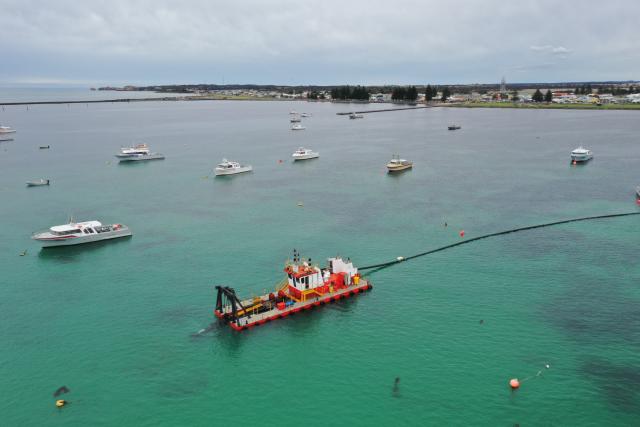
Elsie Adamo
MAJOR dredging works kicked off in Port MacDonnell last week with seaweed and organic material proving more difficult to remove than originally planned.
The major works are being conducted by Maritime Constructions through the Department of Infrastructure and Transport (DIT) and will be ongoing 24 hours a day for three to four months.
The works will remove the significant accumulation of sandy materials and seaweed in the harbour entrance and mooring grounds which has caused difficulties for professional fishermen.
Maritime Constructions environmental and projects manager Simon Spencer said that the dredging works had two major aspects, removing the seaweed wrack from the channel, and the sand from around the moorings.
The initial dredging concept of the seaweed was complicated due to the presence of fine silts that caused screen blockages.
“We have now had to modify the method, but have proven our ability to recover the seaweed in bulk and now have some new engineering solutions proposed,” Mr Spencer said.
“The challenge is to separate the seaweed from the water and we believe we can achieve this now on a larger scale.
“And, in the meantime, we have moved onto the sand dredging component…so we can move on and keep being productive.
“It is a challenging project but it is nothing we are unfamiliar with.”
Mr Spencer said he was hopeful the problem will not cause any delays in the schedule.
“It is early days, we are expecting to be on site for three or four months.
“Some days will be productive, and we will advance quite quickly and other days not so much due to working around moorings and fishing vessels.
“We are also expecting to have some weather delays inside that timeline.
“It is important we that we work within our EPA licence requirements and will be continually monitoring water quality.”
With the work being the first dredging project in the bay since 2006, Mr Spencer said it could not be estimated how long before dredging will need to occur again.
“The sand dredging will have a fairly long-term impact…I expect it would be good for five years,” he said.
“However, it is uncertain in terms of the organic and seaweed inside the channel once dredged how long before they return due to a range of influences from inside and outside the harbour.”
Sand removed from the bay will be placed onto Port MacDonnell beaches and should only have a short-term effect.
The sand discharge will be grey during dredging due to the time spent in water, likely with an initial odour.
The sand will return to its natural colour as it dries within 12 to 24 hours.
“The beach will probably be slightly taller in its height due to the extra sand on the beach,” Mr Spencer said.
“But we are expecting heavy wave action will disperse it naturally along the beach, and it is unlikely for there to be long term visible changes in beach shape or profile.”
Deputy Mayor for Grant District Council and Port MacDonnell resident Gill Clayfield said the harbour’s conditions had been disrupting the professional fishermen.
“A lot of the fishermen could only fill their boats with fuel in the wharf on a high tide, and some could only get to their moorings on a high tide,” Ms Clayfield said.
“It even impacts the large recreational boats; I think it will make a huge difference.
“The fishing industry is going through a slump at the moment because of the trouble with China, but it is a multi-million-dollar industry that the whole Limestone Coast benefits from not just Port MacDonnell.”
A long process to get to this point, Ms Clayfield said the community is relieved it is finally happening.
“They have been trying for over two years to get this to happen, but they had to meet the requirements of the Environmental Protection Authority (EPA),” she said.
“It has been a really connected process, everyone has been kept informed all the way.”
Ms Clayfield said residents will need to be prepared that beaches may look different for a while but will return to normal.
“I live on the beachfront, I believe the sand is going to come along in front of my house, but it is not going to be there long term,” she said.
“If it is going to fix the problem for a large number of years, a little bit of work on the beach in front of us is hardly going to matter.”







